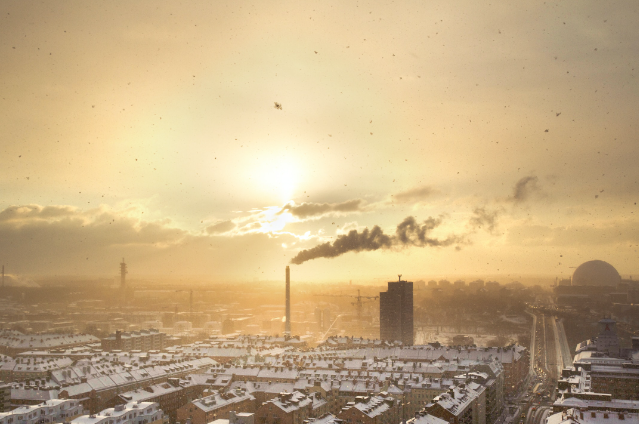
Photo by NOAA on Unsplash
Embraced within the stratospheric expanse of Earth's atmospheric milieu, the venerable ozone layer emerges as an ethereal custodian orchestrating an empyreal symphony of paramount cosmic protection. This virtuoso ensemble, comprising a tripartite triad of oxygen atoms adorning the triumphant triatomic ozone (O3), assumes a profound role in fortifying Earth's delicate biosphere against the pernicious encroachments of ultraviolet (UV) radiation. Within the labyrinthine folds of its molecular ballet, the ozone layer deftly conducts a harmonious symphony of intricate physical and chemical processes, evoking the semblance of an ethereal conductor presiding over this enigmatic cosmic safeguard. This cerebral exegesis embarks on an erudite odyssey, a meticulous sojourn through the unfathomable depths of this poignant symphony, exploring its multifarious subtopics, their profound technicalities, and thought-provoking intricacies, underpinned by an opulence of resplendent vocabulary, elucidative examples, and statistical revelations.
At the very epicenter of this celestial conductor lies a tripartite triad, a virtuoso ensemble of oxygen atoms, materializing as diatomic oxygen (O2) and the triumphant triatomic ozone (O3). The genesis of ozone formation is catalyzed by the resplendent radiance of solar UV radiation, predominately encompassing the formidable UV-C and UV-B range, where wavelengths breach the 240 nanometers threshold. The sublime photodissociation of molecular oxygen by these high-energy photons begets the emergence of reactive oxygen atoms (O), whose intricate tango with molecular oxygen (O2) engenders the birth of ozone through a symphonic cascade of resonant reactions. The photodissociation of molecular oxygen by solar UV radiation yields reactive oxygen atoms, which dynamically react with molecular oxygen to usher in the enigmatic genesis of ozone, epitomizing the symphonic interplay of chemical processes within the ozone layer. Moreover, this elemental symphony of ozone formation is remarkably influenced by atmospheric dynamics, such as temperature, pressure, and solar radiation intensity. The complex interplay of these factors shapes the delicate equilibrium between ozone production and destruction, creating an intricate symphonic ballet of atmospheric composition and distribution.
The harmonious oscillations of Earth's diurnal chronicle bequeath variegated nuances within the ozone layer, as epitomized by the complexities of diurnal cycles. Embracing the penumbra of daylight, the sun's resplendent radiance galvanizes an exuberant outpouring of ozone production, culminating in an ethereal crescendo of heightened concentrations within the stratosphere. The solar UV-B and UV-C radiation actively engenders photodissociation of molecular oxygen, liberating reactive oxygen atoms that participate in a symphony of cascading reactions, ultimately leading to ozone synthesis. In the diurnal chronicle, ozone production reaches a zenith during daylight hours due to intense solar radiation, while the nocturnal cadence engenders reduced ozone production, attesting to the symphonic intricacies of ozone concentration variation. As twilight ascends and solar photodissociation recedes, the veiled cadence of atmospheric cooling orchestrates a gradual diminishment in ozone levels, bestowing a poignant diminuendo on the symphonic score of atmospheric composition. This orchestrated ebb and flow of ozone concentrations manifest diurnal variations that extend across spatial and temporal dimensions, imposing a symphonic rhythm on the stratospheric domain.

Photo by Petter Rudwall on Unsplash
This celestial symphony of the ozone layer reverberates with a meticulously choreographed spatial symphony, endowing a stratified distribution within the stratospheric domain. At its zenith resides the grandiose "ozone maximum," an ethereal crescendo of concentration manifesting approximately 25 kilometers above Earth's terrestrial expanse. The crescendo of this symphonic distribution synergistically entwines with the mesmeric dynamics of the stratosphere, wherein prevailing circulation patterns and enigmatic phenomena such as polar vortexes infuse a symphonic impression upon the melodic tapestry of ozone dispersion. Furthermore, this symphony of spatial distribution is intricately modulated by the synergistic interplay between stratospheric transport processes and ozone production and destruction mechanisms. Stratospheric circulation patterns, governed by winds and temperature gradients, act as the orchestral conductor, regulating the spatial dispersion of ozone concentrations and manifesting diverse atmospheric symphonies across the globe.
Regrettably, the celestial symphony of the ozone layer finds itself besieged by a cacophony of anthropogenic dissonance, predominantly orchestrated by the malevolent release of ozone-depleting substances (ODS). Chief among these malevolent trespassers are the lamentable chlorofluorocarbons (CFCs), hydrochlorofluorocarbons (HCFCs), and halons, surreptitiously ascending to the stratosphere, enacting a symphonic disintegration of ozone molecules. The insidious release of CFCs and HCFCs from anthropogenic sources engenders the unpropitious emission of chlorine and bromine radicals within the stratosphere, culminating in a symphonic chain reaction of ozone disassembly, substantiating the inimical impact of anthropogenic trespasses. These pernicious compounds, pervasively transformed by solar photodissociation in the upper stratosphere, liberate chlorine and bromine radicals, thus catalytically engendering an intricate chain reaction of ozone disassembly, concluding with a lamentable symphonic finale of ozone depletion. This harmonious dissonance of anthropogenic impacts necessitates concerted international endeavors to mitigate ozone depletion, accentuating the imperativeness of the 1987 Montreal Protocol. Scientific observations reveal that prior to the implementation of the Montreal Protocol in 1987, the global concentration of ozone-depleting substances (ODS) had reached alarming levels, with atmospheric levels of ozone declining at an average rate of 4% per decade. This disheartening symphonic diminuendo paved the way for an unprecedented ozone hole formation in the polar regions, with the Antarctic ozone hole reaching a peak size of approximately 29.9 million square kilometers in September 2006, a haunting testament to the impact of human actions on our atmospheric sentinel.
The crescendo of scientific endeavors finds its crescendo in a symphony of wisdom, poised to decipher the elusive opus of the ozone layer. Embodied in the grandiose sonatas of Earth-observing satellite missions such as NASA's Aura and NOAA's Suomi NPP, the symphonic precision of ozone monitoring orchestrates global measurements of ozone concentrations and their gracefully evolving temporal cadence. These satellites employ cutting-edge instruments, such as the Ozone Monitoring Instrument (OMI), that leverage spectral analysis to capture the absorption of solar radiation by ozone molecules, facilitating a symphonic ensemble of precise ozone measurements. Through the grand majesty of ground-based instruments like Dobson spectrophotometers, humanity engenders the orchestration of an intricate atmospheric model, resplendent with predictive capabilities for the symphonic choreography of ozone dynamics. These soaring endeavors resonate in consonance with ground-based observations from the Global Atmosphere Watch (GAW) network, a harmonious symphony of observatories instrumental in capturing atmospheric composition data, epitomizing a resplendent symphony of scientific rigor in ozone monitoring.

Photo by Markus Spiske on Unsplash
As we stand at the precipice of Ozone Day, the ethereal realm of the ozone layer beckons humanity to embrace the exalted mantle of environmental stewardship, orchestrating a harmonious ode of conservation. Amidst the crescendo of anthropogenic cacophony, a symphony of collective endeavor arises, curbing our dissonant contributions and orchestrating the resplendent preservation of this celestial maestro. Together, let us nurture the resplendent notes of ozone layer preservation, weaving a cadence of restoration and resilience, safeguarding this ethereal symphony for generations yet to come. In the empyrean pantheon of environmental custodianship, the resplendent symphony of ozone preservation shall reverberate as an eternal ode to Earth's celestial ensemble.
